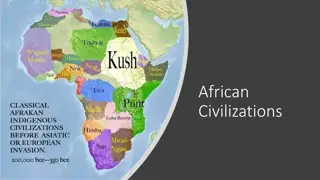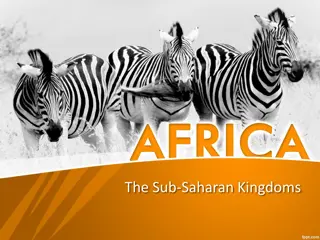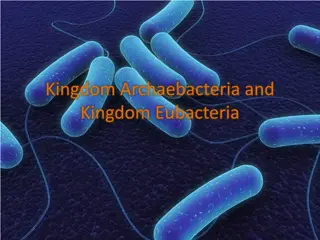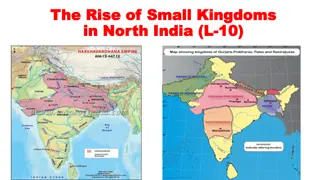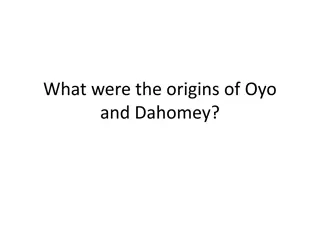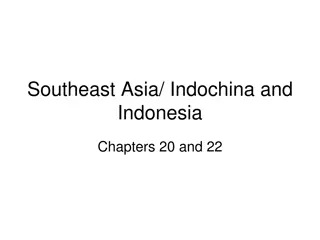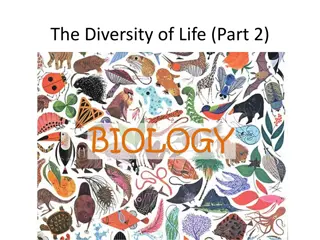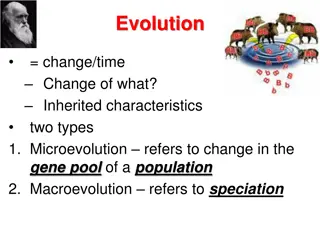Exploring the Six Kingdoms of Life
Delve into the fascinating world of the six kingdoms – Archaea, Eubacteria, Protista, Fungi, Plantae, and Animalia. Discover their unique characteristics, reproduction methods, cell types, food sources, and example organisms. From extremophiles in volcanic vents to ancient trees that live for centuries, each kingdom offers a diverse and intriguing glimpse into the wonders of life on Earth.
Download Presentation

Please find below an Image/Link to download the presentation.
The content on the website is provided AS IS for your information and personal use only. It may not be sold, licensed, or shared on other websites without obtaining consent from the author. Download presentation by click this link. If you encounter any issues during the download, it is possible that the publisher has removed the file from their server.
E N D
Presentation Transcript
Emma Axelson 7th period
The 6 Kingdoms Domain Archea Kingdom Archea Domain Eubacteria Kingdom Eubacteria Domain Eukarya Kingdom Protista Kingdom Fungi Kingdom Plantae Kingdom Animalia
Kingdom Archaea Reproduction: Archaea reproduce asexually, using binary fission Fun facts: Archaea have been found in extreme environments like volcanic vents, geysers, and deep in the ocean. Cell Type: Archaea are prokaryotes without a nucleus in the cell. Body structure : Archaea are single- celled organisms ,but they are sometimes found in colonies. Food: Archaea are autotrophic(make their own food). They use chemical synthesis to make food. Example Organisms: Some examples are Acidianus hospitalis and Methanococcus jannaschii.
Kingdom Eubacteria Example Organisms: Some example bacteria are E.coli , H.pylori, and L.acidopilus. Fun facts: Eubacteria can be found in the human body and are especially important for digestion. Cell Type: Eubacteria are prokaryotic cells(no nucleus). Food: Eubacteria are both auto- and heterotrophic. When they are autotrophic, they use both chemical synthesis and photosynthesis. Reproduction: Eubacteria use asexual reproduction by binary fission. Body Structure: Eubacteria are single- celled organisms.
Kingdom Protista Cell Type: Protists are eukaryotic cells (nucleus and membrane bound organs). Reproduction Asexual binary fission multiple fission Sexual Conjugation Food: Protists can be autotrophic or heterotrophs. Example Organisms: Some examples of protists are slime molds, algae, amoebas, protozoa, and water molds. Fun Facts: Protists can have traits of plants, animals, and fungi. Body Structure: Protists are single-celled, and simple multi-celled.
Kingdom Fungi Cell Type: Fungi have eukaryotic cells (have a nucleus). Examples: Some examples of fungi are Hygrocybe calyptriformis (pink waxcap fungus) and Gomphus clavatus (Pig's Ear fungus). Fun Facts: Some medicines, such as Penicillin, are made from fungi. Body Structure: Fungi are complex multicellular organisms. Their cells have cell walls. Food: Fungi are decomposers. They break down other organisms and absorb the nutrients. Reproduction Asexual Fragmentation Spores spread by the wind Sexual Spores join sexual cells in the fungus.
Kingdom Plantae Fun Facts: Some plants, especially trees, can live for hundreds or even thousands of years! Cell Type: Plants have eukaryotic cells. Body Structure: Plants are complex multicellular organisms with cell walls and chlorophyll. Food: Plants are autotrophic; they make their food using photosynthesis. Photosynthesis uses the sun as a food source. Reproduction: Plants usually reproduce sexually through the process of pollination. A few, such as mosses and ferns, reproduce asexually using spores. Example Organisms: Some plants are trees, grass, ferns, flowers, and many others.
Kingdom Animalia Cell Type: Animals have eukaryotic cells. Food: All animals are heterotrophic. Most are consumers, but some are decomposers. Fun Facts: Many animals have specialized sense organs. Reproduction: Almost all animals reproduce sexually. Body Structure: Animals are complex multicellular organisms. Some are vertebrates (have backbones) and some are invertebrates (no backbone). Example Organisms: There are many different species of animals. Some are humans, beetles, sea anemones, monkeys, rabbits, and dogs.
Sources Information Pictures vedicsciences.net fda.gov medicalrf.com kidsbiology.com docstoc.com autocww2.colorado.edu microbiologyonline.org.uk www.wisegeek.com plainadventure.com ec.europa.eu http://www.biology4kids.com/f iles/studies_kingdoms.html http://www.biology4kids.com/e xtras/show_kingdoms/index.ht ml (2008). GA life science. (pp. 246-400). Holt, Rinehart, and Winston.





